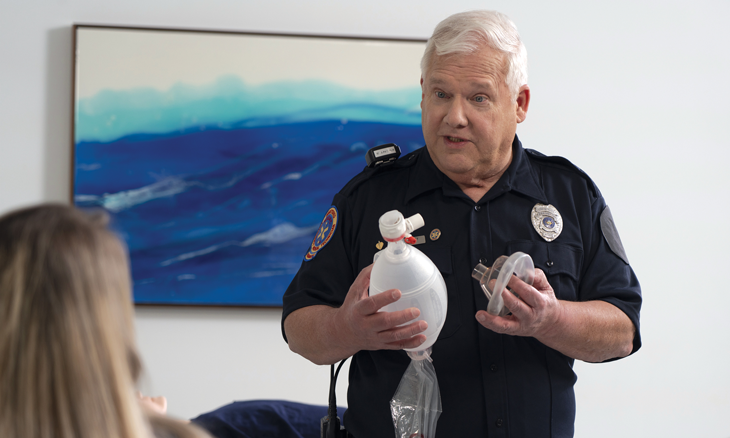
New Life After Back Pain
For ten years, debilitating back pain was part of John Birney’s daily life. It affected his stance and ability to walk, eventually forcing him to give up a job he loved as a paramedic and go on disability. When it got so bad he couldn’t move at all, he was taken to the Bayhealth Emergency and Trauma Center, Kent Campus where he met Bayhealth Neurosurgeon Amit Goyal, MD. Birney’s current state and the fact he’d had a back operation indicated he might be a candidate for robotic spine surgery, but diagnostic images and a subsequent office visit allowed Dr. Goyal to thoroughly assess his condition and discuss treatment options.
His journey began in 2009, when Birney was injured on the job while lifting a patient. He was referred to a large academic medical center out of state where a spinal fusion surgery still left him with back pain that worsened over time.
“I’d gotten used to living with the pain, but could hardly do anything and depended on my family a lot. I tried to avoid pain medication because as a paramedic, I saw firsthand what opioids can do to people,” he said.
Dr. Goyal offered some conservative treatments first, including physical therapy and a steroid injection, but they didn’t help. An MRI confirmed severe stenosis in Birney’s lumbar spine above his past fusion. “It’s not uncommon to see the fused area is fine, but the level above or below has degenerated, causing nerve pressure,” Dr. Goyal said. “It became clear the pain had taken over John’s life and surgery was the right path for him.”
Fortunately for Birney, Bayhealth had the ExcelsiusGPS® robotic spine system, having been the first in Delaware to offer the revolutionary technology. Using real-time display of medical images and GPS mapping, the system’s robotic arm aids the neurosurgeon in implanting hardware with near-perfect precision. It’s ideal in cases like Birney’s where an operation has altered the spinal anatomy. It can facilitate a minimally invasive approach in some cases with smaller incisions and less scarring, and is safer and poses less complication risk than traditional back surgery. Other typical advantages are a faster recovery and shorter hospital stay.
Dr. Goyal performed a laminectomy to remove bone and soft tissue that was compressing the nerves and then used robot assistance to extend Birney’s fusion with new screw and rod placement. While Dr. Goyal expected the surgery would improve his quality of life, he said Birney’s outcome was optimal. “His pain improved dramatically right away. He’s now standing up much straighter since his nerves have more room.”
After a smooth recuperation, Birney was able to get back to activities he couldn’t do for years. “I thought the operation might give me some relief, but I was totally amazed how well it worked.” He describes his life now as completely pain-free. He’s taking two-mile-long walks and planning his next hunting trip since he can handle the physical side of the sport again. He was glad to return to his camp master responsibilities with a local scouting organization and resume teaching CPR classes in the community, which he’d stopped when he could no longer bend to demonstrate techniques to his students.
“Dr. Goyal was straightforward and made me feel comfortable about the surgery,” said Birney. “The difference has been like night and day. A whole new world has opened up since the surgery and I couldn’t be happier with the result.” He described his overall Bayhealth experience as a very positive one, from start to finish. “I’ve had procedures at a lot of hospitals and some very well-known ones, and was really impressed with the care I received at Bayhealth. All my questions were answered, any needs I had were immediately taken care of. The whole process was excellent.”
Visit Bayhealth.org/Robotic-Spine-Surgery to learn more about the Bayhealth Neurosurgery team and view a video about this procedure.
